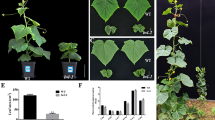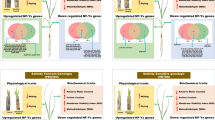Abstract
Plants are exposed to various environmental stresses such as drought, cold, and high salinity during their sessile lifetime. The Late-Embryogenesis Abundant (LEA) proteins are involved in protection against different environmental stresses. LEA proteins have been classified into 7 groups based on sequence similarity and conserved domains. Among these groups, the functions of only group 1, 2 and 3 genes in regulating abiotic stress tolerance have been investigated. The productivity of watermelon (Citrullus lanatus), the most economically important cucurbitaceous crop, is affected by environmental stresses, but the functions of environmental stress-related genes in watermelon have not been reported yet. Therefore, abiotic and biotic stress-related research on watermelon is necessary. In this study, we selected Cl017745 (ClLEA3-1) as a representative group 3 LEA protein based on the watermelon database (http://www.icugi.org) and reported its expression patterns in response to diverse stresses and ABA treatment. Tissue-specific expression pattern of ClLEA3-1 was induced by dehydration, low-temperature, high-salinity, and abscisic acid (ABA) treatment, but expression of ClLEA3-1 was not increased by inoculation with a pathogen. Subcellular localization analysis showed that ClLEA3-1 was a cytosolic protein. Therefore, we recommend that ClLEA3-1 (Cl017745) can be used as an abiotic stress marker gene in watermelon.
Similar content being viewed by others
Literature Cited
Ahn, C.S., J.A. Han, and H.S. Pai. 2013. Characterization of in vivo functions of Nicotiana benthamiana RabE1. Planta 237:161–172.
Ahuja, I., R.C. de Vos, A.M. Bones, and R.D. Hall. 2010. Plant molecular stress responses face climate change. Trends Plant Sci. 15:664–674.
Bahieldin, A., H.T. Mahfouz, H.F. Eissa, O.M. Saleh, A.M. Ramadan, I.A. Ahmed, W.F. Dyer, H.A. El-Itriby, and M.A. Madkour. 2005. Field evaluation of transgenic wheat plants stably expressing the HVA1 gene for drought tolerance. Physiol. Plant 123:421–427.
Bies-Etheve, N., P. Gaubier-Comella, A. Debures, E. Lasserre, F. Jobet, M. Raynal, R. Cooke, and M. Elseny. 2008. Inventory, evolution and expression profiling diversity of the LEA (late embryogenesis abundant) protein gene family in Arabidopsis thaliana. Plant Mol. Biol. 67:107–124.
Boyer, J.S. 1982. Plant productivity and environment. Science 218:443–448.
Browne, J., A. TunnacliVe, and A. Burnell. 2002. Anhydrobiosis: Plant desiccation gene found in a nematode. Nature 416:38.
Chung, E., S.Y. Kim, S.Y. Yi, and D. Choi. 2003. Capsicum annuum dehydrin, an Osmotic-Stress Gene in Hot Pepper Plants. Mol. Cells 15:327–332.
Dalal, M., D. Tayal, V. Chinnusany, and K.C. Bansal. 2009. Abiotic stress and ABA-inducible Group 4 LEA from Brassica napus plays a key role in salt and drought tolerance. J. Biotechnol. 139:137–145.
Du, D.L., Q.X. Zhang, T.G. Cheng, H.T. Pan, W.R. Yang, and L.D. Sun. 2013. Genome-wide identification and analysis of late embryogenesis abundant (LEA) genes in Prunus mume. Mol. Biol. Rep. 40:1937–194.
Dure, I.L., S.C. Greenway, and G.A. Galau. 1981. Developmental biochemistry of cottonseed embryogenesis and germination: changing messenger ribonucleic acid populations as shown by in vitro and in vivo protein synthesis. Biochemistry 20:4162–4168.
Finkelstein, R., S. Gampala, and C. Rock. 2002. Abscisic acid signaling in seeds and seedlings. Plant Cell 14:S15–S45.
Jaspard, E., D. Macherel, and G. Hunault. 2012. Computational and Statistical Analyses of Amino Acid Usage and Physico-Chemical Properties of the Twelve Late Embryogenesis Abundant Protein Classes. PLoS ONE 7:1–5.
Kim, S.J., M.Y. Ryu, and W.T. Kim. 2012. Suppression of Arabidopsis RING-DUF1117 E3 ubiquitin ligases, AtRDUF1 and AtRDUF2, reduces tolerance to ABA-mediated drought stress. Biochem. Biophys. Res. Commun. 420:141–147.
Kim, S.J. and W.T. Kim. 2013. Suppression of Arabidopsis RING E3 ubiquitin ligase AtATL78 increases tolerance to cold stress and decreases tolerance to drought stress. FEBS Lett. 587:2584–2590.
Knight, C. D., A. Sehgal, K. Atwal, J. C. Wallace, D. J. Cove, D. Coates, R. S. Quatrano, S. Bahadur, P. G. Stockley, and A. C. Cuming. 1995. Molecular responses to abscisic acid and stress are conserved between moss and cereals. Plant Cell 7: 499–506.
Kong, Q.S., J.X. Yuan, L.G. Gao, S. Zhao, W. Jiang, Y. Huang, and Z. Bie. 2014. Identification of Suitable Reference Genes for Gene Expression Normalization in qRT-PCR Analysis in Watermelon. PLoS ONE 9:e90612.
Liang, J., M.Q. Zhou, X. Zhou, Y.J. Jin, M. Xu, and J. Lin. 2013. JcLEA, a Novel LEA-Like Protein from Jatropha curcas, Confers a High Level of Tolerance to Dehydration and Salinity in Arabidopsis thaliana. PLoS ONE 8:e83056.
Liu, Y., L. Wang, X. Xing, L. Sun, J. Pan, X. Kong, M. Zhang, and D. Li. 2013. ZmLEA3, a Multifunctional Group 3 LEA Protein from Maize (Zea mays L.), is Involved in Biotic and Abiotic Stresses. Plant Cell Physiol. 54:944–959.
Marina, B., O.C. Yadira, G. Alejandro, C. Francisco, and A.C. Alejandra. 2008. The Enigmatic LEA Proteins and Other Hydrophilins. Plant Physiol. 148:6–24.
Michaela H. and K. H. Dirk. 2008. LEA (Late Embryogenesis Abundant) proteins and their encoding genes in Arabidopsis thaliana. BMC Genomics 9:118.
NDong, C., J. Danyluk, K.E. Wilson, T. Pocock, N.P. Huner, and F. Sarhan. 2002. Cold-regulated cereal chloroplast late embryogenesis abundant-like proteins: molecular characterization and functional analyses. Plant Physiol. 129:1368–1381.
Park, B.J., Z.C. Liu, A. Kanno, and T. Kameya. 2005. Genetic improvement of Chinese cabbage for salt and drought tolerance by constitutive expression of B. napus LEA gene. Plant Sci. 169:553–558.
Redman, R.S., S. Freeman, D.R. Clifton, J. Morrel, G. Brown, and R.J. Rodriguez. 1999. Biochemical Analysis of Plant Protection Afforded by a Nonpathogenic Endophytic Mutant of Colletotrichum magna, Plant Physiol. 119:795–804.
Regina, K., J. Silvola, and P. J. Martikainen. 1999. Short-term effects of changingwater table on N2O fluxes from peat monoliths from natural and drained boreal peatlands. GCB Bioenergy 5:183–189.
Shinozaki, K., K. Yamaguchi-Shinozaki, and M. Seki. 2003. Regulatory network of gene expression in the drought and cold stress responses. Curr. Opin. Plant Biol. 6:410–417.
Siddiqui, N.U., H.J. Chung, T.L. Thomas, and M.C. Drew. 1998. Abscisic acid -dependent and -independent expression of the carrot lateembryogenesis abundant-class gene Dc3 in transgenic tobacco seedlings. Plant Physiol. 118:1181–1190.
Wise, M.J. 2003. LEAping to conclusions: a computational reanalysis of late embryogenesis abundant proteins and their possible roles. BMC Bioinf. 4:52.
Xiao, B., Y. Huang, N. Tang, and L. Xiong. 2007. Over-expression of a LEA gene in rice improves drought resistance under the field conditions. Theor. Appl. Genet. 115:35–46.
Xu, D., X. Duan, B. Wang, B. Hong, T.H.D. Ho, and R. Wu. 1996. Expression of a late embryogenesis abundant protein gene, HVA1, from barley confers tolerance to water deficit and salt stress in transgenic rice. Plant Physiol. 110:249–257.
Author information
Authors and Affiliations
Corresponding author
Rights and permissions
About this article
Cite this article
Kim, S.J., Huh, Y.C., Ahn, YK. et al. Watermelon (Citrullus lanatus) late-embryogenesis abundant group 3 protein, ClLEA3-1, responds to diverse abiotic stresses. Hortic. Environ. Biotechnol. 56, 555–560 (2015). https://doi.org/10.1007/s13580-015-0054-9
Received:
Revised:
Accepted:
Published:
Issue Date:
DOI: https://doi.org/10.1007/s13580-015-0054-9




